

Fort Shantok. La plénitude drastique du devenir-indien. Deux formes de luttes amérindiennes La cosmopolitique Yanomani et le plurinational communautaire bolivien. Mohegan Sacred Sites: Moshup’s Rock. Categories: Belief, Historic Preservation, Montville, Native Americans Mohegan Sacred Sites: Moshup’s Rock “You shall always remain in [the land] where your [creator] is.”
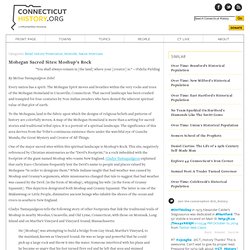
—Fidelia Fielding By Melissa Tantaquidgeon Zobel Every nation has a spirit. Breaking the Myth of the Unmanaged Landscape. Categories: Agriculture, Environment, Exploration and Discovery, Ledyard, Native Americans, North Stonington Breaking the Myth of the Unmanaged Landscape Lantern Hill, adjacent to the Eastern Pequot reservation, North Stonington, showing Lantern Hill Pond, the former Silex mining operation, and the municipal landfill, 1997 - Photograph by Tobia Glaza By Tobias Glaza, with Paul Grant-Costa for Connecticut Explored.
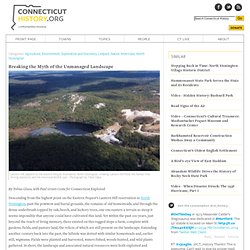
Tribes and Villages of New York. Maps of Native American Nations, History, Info. Index of Native American Resources on the Internet - WWWVL American Indians. Main Menu: Native American Indian PlentyStuff. The Mohegan Tribe: Heritage - Our Stories. In Mohegan tradition, as in all indigenous cultures, balance is important.
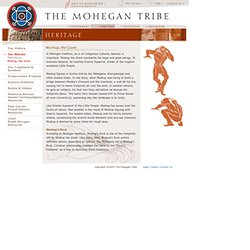
Moshup the Giant represents the large and great beings. To maintain balance, he marries Granny Squannit, leader of the magical woodland Little People. Moshup figures in stories told by the Mohegans, Wampanoags and other coastal tribes. In one story, when Moshup was trying to build a bridge between Martha's Vineyard and the mainland, a crab bit his toe, causing him to leave footprints all over the area. In another version, he gets so irritated, his feet turn fiery red before he stomps his footprints about. Mohegan people. Not to be confused with the Mahican or Mohawk, different Native American tribes.
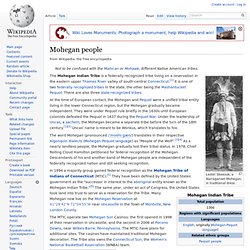
Mohawk Council of Akwesasne. Magazine - Hoaxes, Fakes, and Strange Sites - Walam Olum Hokum. Eccentric nineteenth-century scholar Constantine Rafinesque composes a Native American epic Constantine Rafinesque According to the 19th-century scholar Constantine Rafinesque, an ancient Lenape (Delaware) Indian tradition preserved the memory of the tribe crossing the frozen Bering Strait from Asia into America thousands of years ago.

Rafinesque said his source, which he translated himself, was the Walam Olum or "Red Record," a bundle of wooden plaques engraved and painted with supposed Lenape symbols. Constantine Samuel Rafinesque. Biography[edit] Rafinesque was born on October 22, 1783[4] in Galata, a suburb of Constantinople.[5][6] His father F.
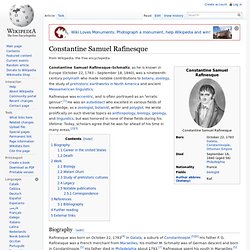
G. Rafinesque was a French merchant from Marseilles; his mother M. Schmaltz was of German descent and born in Constantinople.[5] His father died in Philadelphia about 1793.[7] Rafinesque spent his youth in Marseilles,[5] and was mostly self-educated, he never attended University.[8][9] By the age of twelve, he had begun collecting plants for a herbarium.[10] By fourteen, he taught himself perfect Greek and Latin because he needed to follow footnotes in the books he was reading in his grandmothers' libraries.
Walam Olum. The Walam Olum or Walum Olum, usually translated as "Red Record" or "Red Score," is purportedly a historical narrative of the Lenape (Delaware) Native American tribe.

The document has provoked controversy as to its authenticity since its publication in the 1830s by botanist and antiquarian Constantine Samuel Rafinesque. Ethnographic studies in the 1980s and analysis in the 1990s of Rafinesque's manuscripts have produced significant evidence that the document is a hoax. Some Delaware people, however, believe Rafinesque based his writing on actual Lenape stories.[1] Walam Olum pictograph. Munsee language. Map showing the aboriginal boundaries of Delaware territories, with Munsee territory the lightly shaded northernmost area, and Unami to the south Munsee (also known as Munsee Delaware, Delaware, Ontario Delaware) is an endangered language of the Eastern Algonquian subgroup of the Algonquian language family, itself a branch of the Algic language family.

Munsee is one of the two Delaware languages. It is very closely related to the extinct Unami Delaware, but the two are sufficiently different that they are considered separate languages. Munsee was spoken aboriginally in the vicinity of the modern New York City area in the United States, including western Long Island, Manhattan Island, Staten Island, as well as adjacent areas on the mainland: southeastern New York State, the northern third of New Jersey, and northeastern Pennsylvania.[2][3] Classification[edit] Native Prisoner Penpal List: A-Z. Native American Religious Freedom: Prisoner Letters. Abstract - National Criminal Justice Reference Service. Tools Advanced Search Search Help Menu.

NATIVE AMERICAN FREE EXERCISE OF RELIGION ACT OF 1993. Native American Spirituality In The United States Prison System {Part 3: Native Voices} - Multicultural Familia. Image: Flickr / leafdot Welcome back to our series on Native American Spirituality In The United States Prison System.
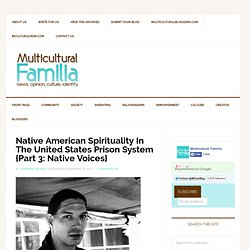
In Part 1 we looked at Native spiritual practices and sacred objects prohibited in prison and their importance. Part 2 presented a brief history of legislation affecting the religious freedom of incarcerated Native Americans. Today we will explore testimony from incarcerated Americans illustrating the need for access to Native religion. While doing research for this post, I was fortunate to come across someone who had just finished a study on incarcerated Native Americans across the United States.
The first question the prisoners were asked was, what religious rights prison authorities had taken away from them. Native American Spirituality In the U.S. Prison System {Part 1: Denial of Religious Rites} - Multicultural Familia. Image credit: Flickr / Luiza Native American Spirituality In the U.S. Prison System For centuries Native Americans struggled to retain and to engage in their traditional spiritual practices in the midst of a society dominated by Judeo-Christian beliefs. Since the coming of Christopher Columbus, Native peoples fought against European expansionists to maintain their traditional cultures, religions, and way of life.
This has been a difficult struggle in free society but even more arduous for those Native Americans who are incarcerated. Native American spirituality is a complex interweaving of beliefs and traditions. Mettanokit. Introduction | Prologue | Chapter 1 | Chapter 2 | Chapter 3 | Chapter 4 | Chapter 5 | Chapter 6 | Chapter 7 | Chapter 8 | Chapter 9 | Epilogue Crime and punishment. We don't need to be persuaded that there is an immense problem in this area at this time. It is a problem on every continent, in every nation. The United States, supposedly the model to the world of the good and successful society, has more people per capita in prisons and jails than any other nation on earth, well over a million people, and prison populations here and everywhere continue to grow. Prison facilities are all overcrowded, there is a boom in prison construction, the most expanding employment opportunity today is that of prison guard, and politicians are demanding longer and mandatory sentences for criminals.
The fact that all of this is not working doesn't seem to initiate any new thinking on this subject. Native American Indian Spiritual Freedom in Prison. Original sketch by Black Crow [this link will open in a new window] Summary Randall Trapp, et al. v. Commissioner DuBois, et al. was filed in 1995 on behalf of a group of inmates who were part of a Native American Spiritual Awareness Council in a Massachusetts prison.
The Council maintained a weekly Circle and other practices associated with American Indian spirituality. Schumer vows to aid (and abet) stalled Sing Sing museum. OSSINING – U.S. Sen. Chuck Schumer vowed Tuesday to "look everywhere to get federal money" to help build a long-discussed museum at Sing Sing Correctional Facility, saying it could be "the Alcatraz of the East. " Figure 13 Importing Constituents. Population Total district population as reported on page 2 of the pdf district map by the New York State Legislative Task Force on Demographic Research and Reapportionment. Further research Importing Constituents - Prisoners and Political Clout in New York.
On Importing Constituents: Prisoners and Political Clout in New York. Incarceration rates in New York. Importing Constituents: Prisoners and Political Clout in Montana. By Peter Wagner December 14, 2004. No Longer on the Map: Forgotten Place Names in Northwestern Westchester. Sing Sing Prison: Liro Store. ORIGIN OF HUDSON RIVER NAMES. - Nearly All Are Corruptions of the Indian or Old Dutch Titles. - View Article. Untitled Document. The Democratic Register March 2nd, 1901 As we have time and again been asked for information as to the derivation and meaning of the name Ossining, which is to be our village name, we give it now for the benefit of all.
What is Sint Sink? "Sint Sink" was the Matinecock (Algonquin) Indian tribe name for the Cow Neck Peninsula on the north shore of Long Island, an area that extends from Hempstead Harbor to Manhasset Bay. "Sint Sink" means "place of many rocks. " Wappinger. Munsee language. The Delaware. Welcome to the Hudson Valley: A Guidebook of Topics in Local Environmental History.
By Gwen Frenzel New York State has long had a large proportion of its residents living in New York City. Plant Utilities Engineer 1 » NYS Department of Corrections and Community Supervision. Singsing - onamissionrevived. History of Sing Sing CF - "Sent up the river" Erie Canal. Relation : New York State Barge Canal (1823647) Singsing - onamissionrevived. The Making Of This Film. Documentary ‘The University of Sing Sing’ to Premiere March 31 on HBO.
Newgate Prison: Up the River - Racontours. Zero Percent Trailer - A Hudson Link Documentary. Sing Sing Prison Documentary. Le documentaire américain Zéro pour cent, en avant-première à Oran : Réinsertion sociale, la preuve ! Portraits: Inmates at Sing Sing Prison with Prison Photos - Images. Documentary Prison Films and the Production of Disciplinary Institutional "Truth" The Rose Man of Sing Sing: A True Tale of Life, Murder, and Redemption in ... - James McGrath Morris. The Shocking Story Of The First Woman Executed By Electric Chair. Newjack: Guarding Sing Sing. Thomas Mott Osborne. Lower Mississippi Valley - Engineering Geology Mapping Program. Upcoming Events Ossining Histo. All about Sing Sing Prison, by Mark Gado — The Beginning. NYCHS excerpts: Mark Gado's 'Stone Upon Stone: Sing Sing Prison' Sing sing prison. Sing Sing Prison - Village of Ossining, New York. Sing Sing Correctional Facility.
1034: Sing Sing Prison. Facility Listing » NYS Department of Corrections and Community Supervision. Sing Sing Correctional Facility - Ossining, NY. Prisoners review their jails on Yelp: The staff at Sing Sing are 'rude' and watch out for the roaches of Rikers Island.